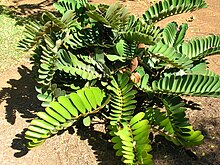Zamia
| Zamia | |
|---|---|
 |
|
| Zamia furfuracea | |
| Scientific classification | |
| Kingdom: | Plantae |
| Division: | Cycadophyta |
| Class: | Cycadopsida |
| Order: | Cycadales |
| Family: | Zamiaceae |
| Genus: |
Zamia L. |
| Synonyms | |
|
|
Zamia is a genus of cycad of the family Zamiaceae, native to Mexico, the West Indies, and Central and South America as far south as Bolivia. The range of one species (Z. integrifolia, extends into the contiguous United States, i.e. Georgia and Florida.
The genus comprises deciduous shrubs with aerial or subterranean circular stems, often superficially resembling palms. They produce spirally arranged, pinnate leaves which are pubescent, at least when young, having branched and simple, transparent and coloured hairs. The articulated leaflets lack a midrib, and are broad with subparallel dichotomous venation. Lower leaflets are not reduced to spines, though the petioles often have prickles. The emerging leaves of many Zamia species are striking, some emerging with a reddish or bronze cast (Z. roesli is an example). Zamia picta is even more distinctive, being the only truly variegated cycad (having whitish/yellow speckles on the leaves).
Zamia sporophylls are born in vertical rows in cones, and the megasporophyll apices are faceted or flattened, not spinose. The fleshy seeds are subglobular to oblong or ellipsoidal, and are red, orange, yellow or rarely white. The endosperm is haploid, derived from the female gametophyte. The embryo is straight, with two cotyledons that are usually united at the tips and a very long, spirally twisted suspensor.
The sperm of the genus are large, as is typical of cycads, and Zamia roezlii is an example; its sperm are approximately 0.4 mm long and can be seen by the unaided eye.
...
Wikipedia
